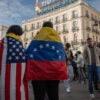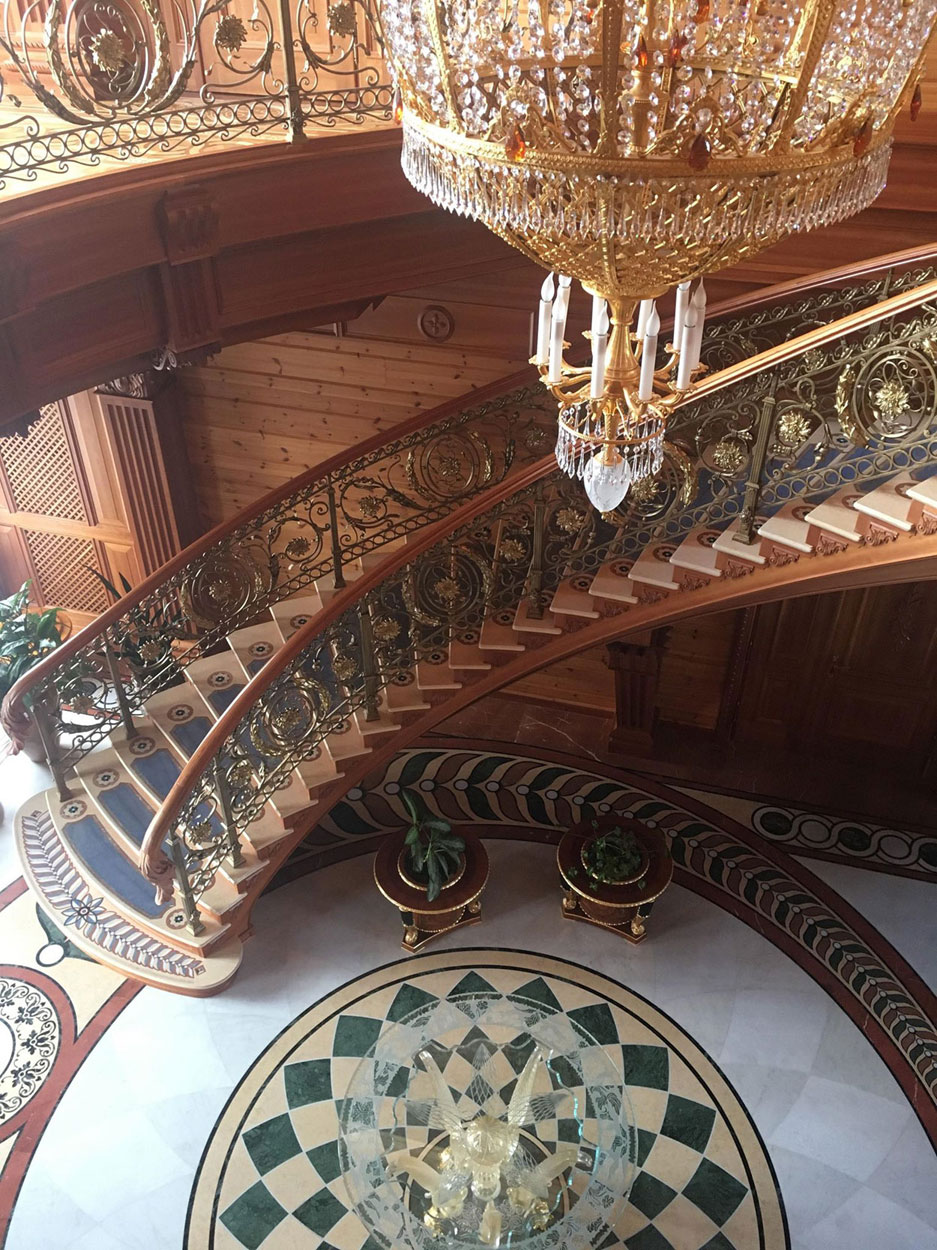KYIV, Ukraine—Four years ago this week, central Kyiv resembled a quieted urban battlefield.
Ukraine’s capital city was, at that time, reeling from months of street protests and a revolution in which nearly 130 people died. The city’s central square, the Maidan, was left a charred ruin, still brimming with protester encampments and ad hoc defensive barricades.
Months earlier, in November 2013, protesters first took to the Maidan to oppose a last-minute decision by Ukraine’s then-President Viktor Yanukovych to ditch a trade deal with the European Union in favor of one with Russia.
Yet, when Yanukovych—a Kremlin lackey—launched a brutal police crackdown on the protesters, those pro-European street protests boiled over into a revolution calling for the then-president’s ouster.

Pedestrians pass before the memorial to fallen protesters at the top of Heroes of the Heavenly Hundred Street in central Kyiv. (Photo: Nolan Peterson/The Daily Signal)
The bloodiest day of the “Revolution of Dignity,” as Ukrainians now call it, was Feb. 20, 2014. On that day, sniper fire killed dozens of people.
At the top of what was then called Institutskaya Street, bodies piled up behind trees, street signs, and light poles—places where the protesters had scrambled for cover.
Yet, incredibly, the protesters kept advancing toward the sound of gunfire, many with only motorcycle helmets and jury-rigged metal shields for protection. Some went into the line of fire simply to drag away their wounded comrades, only to be cut down by a sniper’s bullet in the process.
The nearby lobby of the Hotel Ukraine became a casualty collection point. YouTube videos of that day show a chaotic scene more akin to a front-line MASH unit than a hotel lobby in a European capital city. Blood pooled on the white marble floor as the casualties streamed in. People yelled and cried while doctors stepped over the bodies of the dead as they rushed from one wounded person to the next.
Four years later, on Feb. 20, 2018, the floor of the Hotel Ukraine’s lobby is polished and gleaming. Guests sip drinks casually and quietly while the Winter Olympics play on TV.
A few hundred yards away from the Hotel Ukraine, the Maidan’s wide open, stone-floored expanse is, on this day, still scarred in places from the tires protesters once burned to create a smokescreen from snipers.
For the revolution’s fourth anniversary, Ukrainian officials assembled on the Maidan an array of portraits of those who died—78 of them during the revolution’s climactic final days of Feb. 18 to 20, 2014.

Some of the faces of fallen protesters on the memorial at the top of Heroes of the Heavenly Hundred Street in central Kyiv. (Photo: Nolan Peterson/The Daily Signal)
This memorial display extends across the Maidan onto Khreshchatyk, Kyiv’s main boulevard, which is shut down to traffic for the anniversary commemorations.
Ascending from the Maidan, what used to be Institutskaya Street is now called “Heroes of the Heavenly Hundred Street”—thus renamed in honor of the protesters who died.
At the top of this cobblestone street, at the place where snipers targeted protesters on Feb. 20, 2014, hundreds of Ukrainians gather four years later to lay flowers and pay their respects before a monument of black stone and metal engraved with likenesses of those who died in the revolution.
The gathered crowd comprises all ages. Some who are graying and stooped wear a fur ushanka cap to ward off the cold on this bitter winter day.
There are also soldiers in uniform. Some are young and trim. Others are fat and old. One gray-haired man in street clothes wears a baseball cap that says, “Afghanistan Veteran.”
The etched likenesses of the dead protesters on the black monument are as eclectic as the crowd gathered before it.
Nazar Voytovich, 17 years old.
Volodymyr Kulchytsky, 65 years old.
Scars
Accounts vary as to the identity of the snipers who carried out the Feb. 20, 2014, massacre.
Some Ukrainian intelligence officials and politicians, both current and former, say agents of Russia’s Federal Security Service, or FSB, took part in the shootings.
Members of Ukraine’s now disbanded special riot police force, known as the Berkut, were also said to be involved, according to news reports and Ukrainian officials.
The snipers’ identities remain murky, but concrete, undeniable evidence remains of the violence they inflicted.
At the top of Heroes of the Heavenly Hundred Street, amid the flowers and other memorials, bullet holes still pockmark the trees, street signs, and light poles, as well as the adjacent Hotel Ukraine’s exterior.

An in-and-out bullet hole in a sign pole in central Kyiv provides a line of sight to the place from which a sniper fired on protesters during the February 2014 revolution. (Photo: Nolan Peterson/The Daily Signal)
One metal streetlight pole remains speckled by a constellation of bullet holes about 2 feet above ground level—roughly the height of a crouched person’s torso.
You imagine what it must have been like to be pinned down behind that scanty cover as the bullets pinged, over and over, on the other side, knowing full well that you were squarely in the sniper’s sites and had little chance of escape.
Standing there four years later, you shiver—whether from the cold or something else, you don’t know.
Still, there’s more if you know what to look for.
In a metal sign pole a few yards up the sidewalk, you peer through an in-and-out bullet hole. Like looking through a spyglass trained along the responsible bullet’s trajectory, you see straight to its point of origin—a balcony on a nearby building.
You imagine the sniper there.
“It felt like real war,” wrote Zoryan Kis, campaign coordinator for Amnesty International Ukraine and an eyewitness to the Feb. 20, 2014, sniper attacks.
Artifacts
Yanukovych fled Kyiv in a helicopter on Feb. 22, 2014.
According to witness interviews gathered from court proceedings in Kyiv this January, the deposed Ukrainian president first traveled to the eastern Ukrainian city of Kharkiv before shuffling among safe houses in the region.
Then, according to witness accounts, Russian special operations troops evacuated Yanukovych and his entourage by plane to a Russian military facility in Crimea, whence they flew to Russia on Feb. 23, 2014.
Today, Yanukovych reportedly remains in exile in Russia.
Ukrainian authorities are currently trying the deposed president in absentia for high treason. Yanukovych, for his part, has denied he gave the order to open fire on protesters.
“From the very beginning until the very end, I stood against bloodshed,” Yanukovych told the Svyatoshinsky District Court in Kyiv via a video transmission from Russia on Nov. 28, 2016.
“I am not capable of giving such orders,” he added.
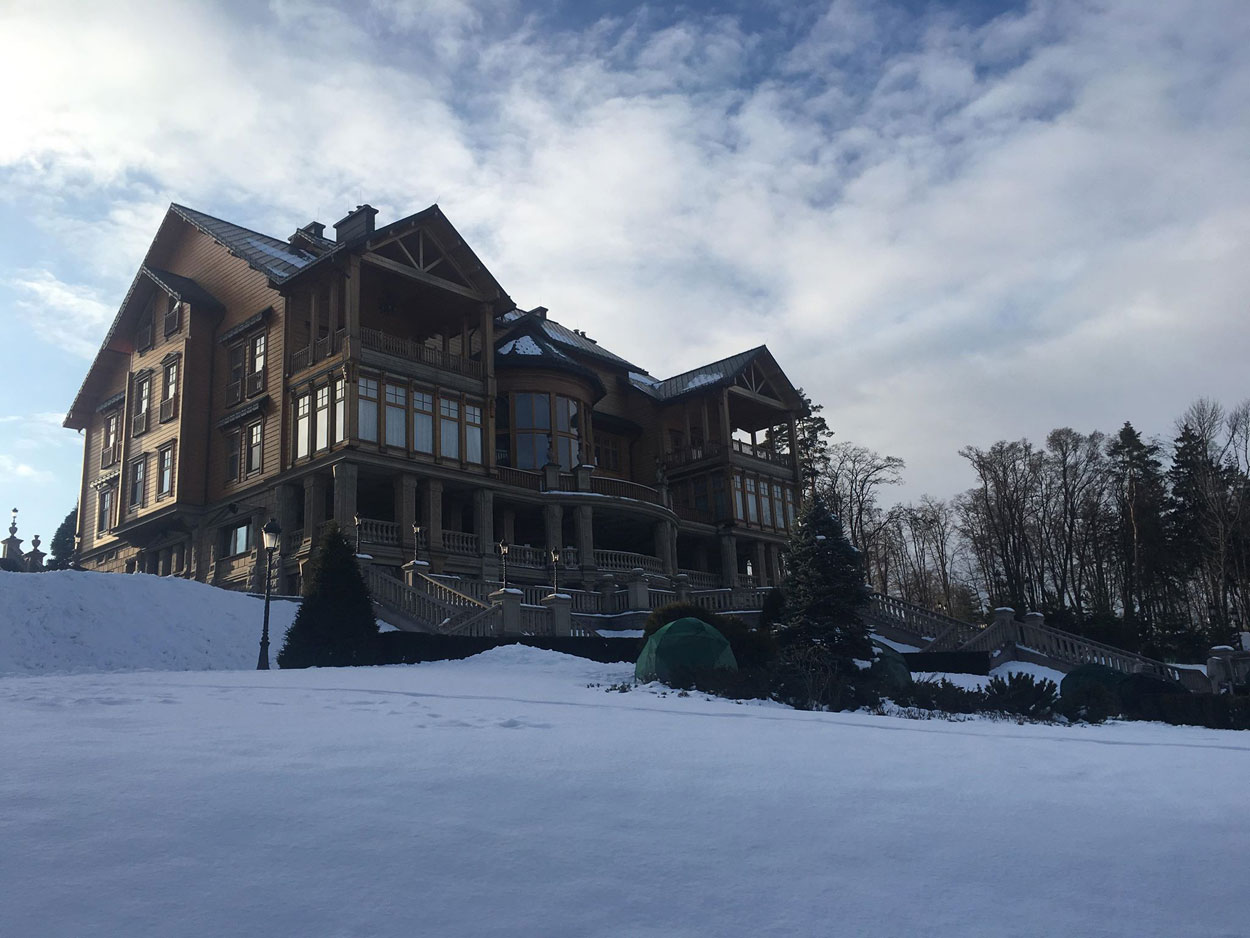
The mansion, known as Honka, of deposed Ukrainian President Viktor Yanukovych. (Photo: Kirsten Diller)
Yanukovych’s dictatorial regime may be over, but artifacts linger of the pervasive, absurd life of luxury the ousted ruler lived, courtesy of the ill-gotten wealth he accumulated while in power.
Thus, a visit to Yanukovych’s palatial former estate, known as Mezhyhirya in Ukrainian, is an illuminating testament to the ethical vacuity of the ousted president’s kleptocratic regime.
About 35 minutes by car from central Kyiv, the 14,000-acre estate overlooks a broad section of the Dnieper River, commonly known as the “Kyiv Sea.”
An electrified fence lines the waterfront.
Mezhyhirya was not visible on Google Maps prior to 2014—only one old Soviet road was depicted. Today, the compound is open to the public and colloquially referred to as the “national anti-corruption museum.” It’s also quite a popular place for Ukrainians to get married these days.
Yanukovych’s now-defunct estate includes a golf course, an ostrich farm, and an entire warehouse for the ousted president’s collection of rare vintage cars.
A floating restaurant built to look like a Spanish galleon—the name “Galleon” is, in fact, written on its stern—remains tied up at a dock down by the Dnieper River shore.
Nearby bird coops contain a flock of specially trained “thoroughbred” pigeons.
Not too far away, an all-granite bridge spans a small pond. On its shore—a posh guesthouse where Libyan dictator Moammar Gadhafi, now deposed and deceased, reportedly once stayed.
This guesthouse is now commonly called the “Putin House,” although Russian President Vladimir Putin never stayed there, Ukrainian officials say.
At a bluff overlooking the river is a sporting complex featuring a full gym—complete with a fresco of naked Greek wrestlers—a cryotherapy room, a tanning booth, an oxygen therapy room, a salt room (for clearing the lungs), as well as an indoor bowling alley and indoor tennis courts.
This was all for one man, remember.
The real panacea of Mezhyhirya’s absurdity, however, is its showcase wooden mansion, known as Honka (the name of a Finnish log cabin construction company), where Yanukovych lived with his mistress, Lyubov Polezhay.
(Inside the sporting complex, a secret door hidden in a fake wall panel—which opens by swiping an electronic key over an unmarked spot—leads to an underground tunnel connecting the facility to Honka.)
The wood for Yanukovych’s sprawling, Scandinavian log cabin-style mansion was imported from Finland. The massive structure was built without nails—the wooden beams were all precisely crafted to fit together like a gigantic Lincoln Logs cabin.
There’s a separate elevator for servants, while Yanukovych’s elevator has a tile mosaic floor and an etched glass door.
A lower level with carved stone walls like a medieval castle contains a movie theater and one of two dining halls—in this one, the main table’s centerpiece is the full skin of a crocodile.
Close by, a plant pot made from python skin continues with the reptile motif.
While conspicuously absent of any hint of taste or identifiable throughline of interior design style, the craftsmanship of Honka is admittedly remarkable. The walls are a mix of expertly carved and polished wood and stone. The floors are made of intricately assembled mosaics of wood and marble. The furnishings are equally as extravagant.
In the living room sits a white Steinway & Sons piano; it bears John Lennon’s signature. There are multiple crystal tables worth more than 100,000 euros a piece, and a music box worth nearly half a million euros.
The walls, however, are noticeably devoid of artwork. Yanukovych’s entourage took most of the valuable stuff when they fled in 2014. The Ukrainian government confiscated and put up for auction much of the remainder.
Before fleeing, Yanukovych’s cohort also destroyed most of the documents related to the estate’s construction. Consequently, the amount of money Yanukovych spent on Mezhyhirya remains a mystery. Further, Yanukovych funded its construction through shell companies, so the legal status of the property and the wealth of assets contained within it remain nebulous.
Officially, Mezhyhirya is not a museum. Nonetheless, the Ukrainian caretakers aren’t letting the grounds fall into disrepair. Even on this quiet, cold February day, the grounds bustle with the work of groundskeepers clearing snow from the sidewalks or tending to the landscaping.
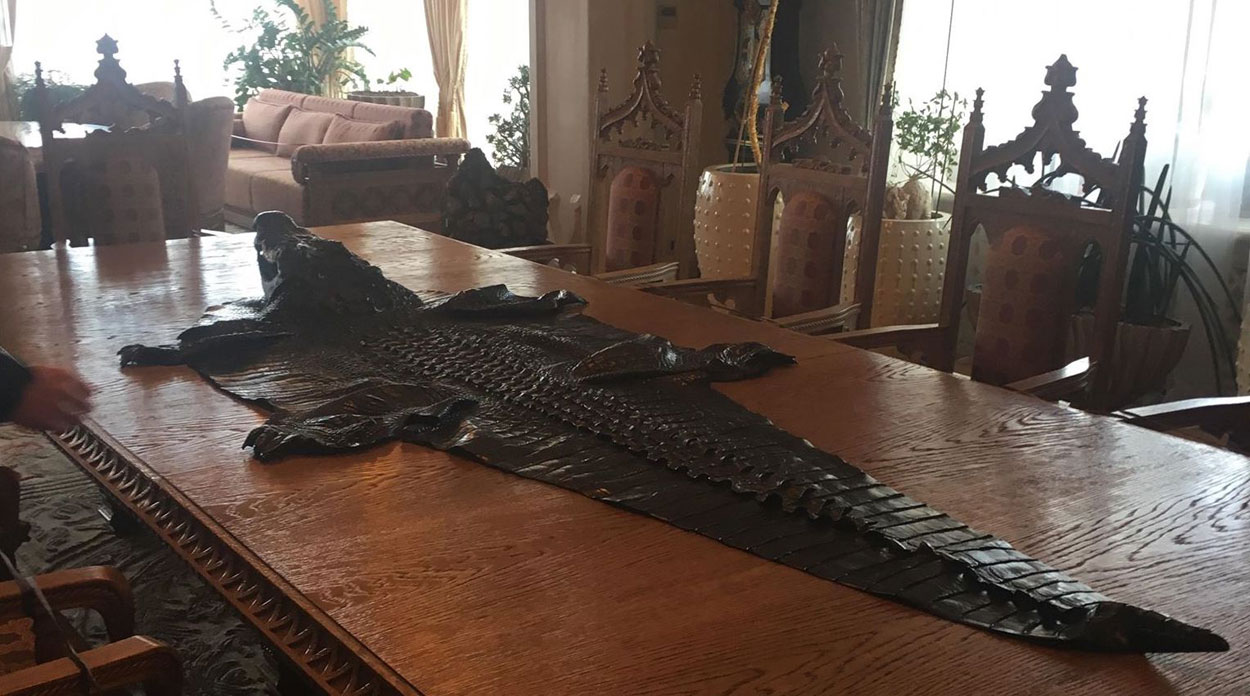
The crocodile skin table centerpiece in deposed Ukrainian President Viktor Yanukovych’s former mansion. (Photo: Joel Diller)
Tarps cover valuable plants as protection from the winter cold. Caretakers still feed and care for the ostriches and the thoroughbred pigeons. Soldiers guard the rare car collection. Honka, the showcase mansion, is immaculately clean inside.
According to staff, maintenance is funded through entrance fee proceeds.
It costs less than $4, or about 100 Ukrainian hryvnias, for a day pass to the grounds.
In 2013, the year prior to the revolution, that same number of hryvnias would have been worth about $12.5—more than three times as much.
Moving Target
Though Yanukovych is long gone, the revolution’s goals remain elusive.
“Even as Ukraine’s soldiers and diplomats fight for the country’s sovereignty and territorial integrity, there is another critical priority for all Ukrainians: fulfilling the dreams of the Maidan for a better, brighter future that is free of corruption,” U.S. Deputy Secretary of State John Sullivan said in Kyiv on Feb. 21, according to a readout posted on the U.S. Embassy in Ukraine’s website.

Days after the anniversary commemoration ceremonies, the memorial to fallen protesters remains covered in flowers. (Photo: Nolan Peterson/The Daily Signal)
Ukraine’s fight against corruption, one of the revolution’s rallying cries, has advanced in some ways. But progress remains frustratingly halting, both in politics and in daily life, in the eyes of many Ukrainians. Judicial reform, for one, remains high on Ukraine’s to-do list.
In a poll conducted in September and October of 2017 by the International Republican Institute, a U.S. think tank, 46 percent of Ukrainians said corruption was among the top three problems facing their country. As a point of comparison, Russia’s ongoing proxy war in the east was among the country’s top three problems in the eyes of 43 percent of those Ukrainians polled.
Moreover, while Ukraine’s economy is slowly recovering from the body blow it took in the wake of the revolution, most Ukrainians remain financially worse off than they were prior to 2014.
The Ukrainian hryvnia’s value slid from about 8 to 1 against the U.S. dollar in 2013, to its current value of roughly 27 to $1. Consequently, inflation is up and the average Ukrainian citizen’s spending power is way down.
The slow pace of reforms and economic malaise have dimmed the hopes of a better future for many Ukrainians, particularly among the younger generations, who have no memory of life in the Soviet Union and have grown up exposed to American and European cultures and standards of living through the internet and entertainment media.
“Since the time of the Orange Revolution it’s just getting worse and worse,” Igor Didenko, a 19-year-old fitness instructor living in Kyiv, told The Daily Signal.
The “Orange Revolution,” colloquially known in Ukraine as the first Maidan, lasted from November 2004 to January 2005.
“Every year, prices are rising for all foodstuffs, utilities, but salaries are not raised,” Didenko said. “Essentially, it’s my opinion that for young people there is nothing to do; all of my friends who could leave did it long ago.”
By an overwhelming margin, inflation is the top issue affecting Ukrainians’ personal lives, the International Republican Institute found.

Bullet holes in a pole serve as a reminder, four years later, of the violence that played out at this spot on Feb. 20, 2014—the bloodiest day of Ukraine’s 2014 revolution. (Photo: Nolan Peterson/The Daily Signal)
“Ukraine’s fight against corruption is no less essential than its fight against Russian aggression,” Sullivan, the deputy U.S. secretary of state, said in Kyiv. “A stable democratic, prosperous, and free Ukraine will be less vulnerable to external threats and serves as a beacon to other nations facing Russian aggression.”
After almost four years, Russia’s proxy war in Ukraine’s eastern Donbas region grinds on while casualties steadily mount. So far, more than 10,300 Ukrainians have died in the conflict. And, on average, one Ukrainian soldier dies every three days.
“Trying to reform Ukraine’s governance, economy, health care, and judiciary while fighting a war of national survival is a bit like trying to build a ship while you are already at sea—not easy,” Luke Coffey, director of The Heritage Foundation’s Foreign Policy Center, wrote last summer.

The engraved likeness of 17-year-old Nazar Voytovich, one of the protesters who died in Ukraine’s 2014 revolution. (Photo: Nolan Peterson/The Daily Signal)
About 60,000 Ukrainian troops remain deployed to the trench lines and embattled villages of the Donbas, weathering daily artillery and sniper pot shots from a combined force of about 35,000 pro-Russian separatists, Russian regulars, and foreign mercenaries.
Thus, the ongoing conflict continues to hang over Ukraine as a sword of Damocles, portending a much larger cataclysm. The chance of an unanticipated or unwanted escalation remains high. Wars often happen, after all, which no one wants.
Ukraine also faces a quiet, ongoing demographic catastrophe as its population continues a steady decline that began after the Soviet Union’s breakup in 1991.
Ukraine’s population decreased by 198,000 in 2017 alone, the State Statistics Service of Ukraine reported Wednesday. The United Nations estimates Ukraine’s population could drop from its current level of 42.3 million to 36.4 million by 2050.
Rays of Light
Some positive changes have occurred in Ukraine since the revolution, such as a sweeping health care reform bill, pension reforms, and some key anti-corruption initiatives. The country’s military has been totally revamped.
Officials plan infrastructure projects across the country—including much-needed road improvements.
Also, Ukrainian civil society has flourished during the past four years, spurring the emergence of civilian “watchdog” groups, which intend to hold the government to account for corruption. This is a trend which, while in its infancy, underscores a departure from the post-Soviet era of thug rule, even if some of these watchdog groups still face substantial government pushback, even outright persecution in some cases.
On the other hand, Ukrainian society is now less insulated from the West than it probably ever was.

Mezhyhirya has become a popular place for Ukrainians to get married. (Photo: Nolan Peterson/The Daily Signal)
Ukrainians now have visa-free travel to the European Union, and last year, the Ukrainian government issued about 4 million biometric international passports, compared with 1.5 million in 2016. At the same time, foreign tourism to Ukraine is increasing and passenger traffic is skyrocketing at the country’s airports.
Ukraine International Airlines, the country’s flagship carrier, plans to double both passengers and aircraft by 2021 and add 38 new cities to its destinations by 2022, the Ukraine Business Journal reported Monday.
Spurred by the pro-Western revolution and four years of war, Ukraine is also in the midst of a cultural and economic divorce from Russia.
“Paradoxically, the Russian aggression designed to divide Ukraine has created great unity of spirit among the Ukrainian people, while deeply damaging Russia’s own reputation and standing in Ukraine and on the world stage,” Sullivan said.
On Khreshchatyk, Kyiv’s central boulevard, street vendors sell rolls of toilet paper and doormats adorned with the likenesses of Putin and Yanukovych. The most popular Russian internet search engines and social media sites are now banned in Ukraine.
Every remaining statue of Vladimir Lenin in the country has come down since 2014. Soviet-era, Russian names of streets and municipalities have been scrapped for Ukrainian ones. Even playing the Soviet national anthem is now officially against the law in Ukraine.
According to International Republican Institute polling data, Ukrainians’ attitudes toward Russia flipped in the revolution’s wake.
In the intervening months between February and September of 2014, the number of Ukrainians with a “warm” feeling toward Russia dropped from 51 percent to 15 percent—and the number of Ukrainians with a “cold” feeling toward Russia jumped from 19 percent to 66 percent.
Still, despite Moscow’s ongoing proxy war in the east, Russia remains Ukraine’s top single-country trading partner.
Four years on from the revolution, much remains to be done in Ukraine’s two-front war against corruption and Russian aggression. Yet, some say a tipping point has been passed and things won’t likely go back to the way they were before.
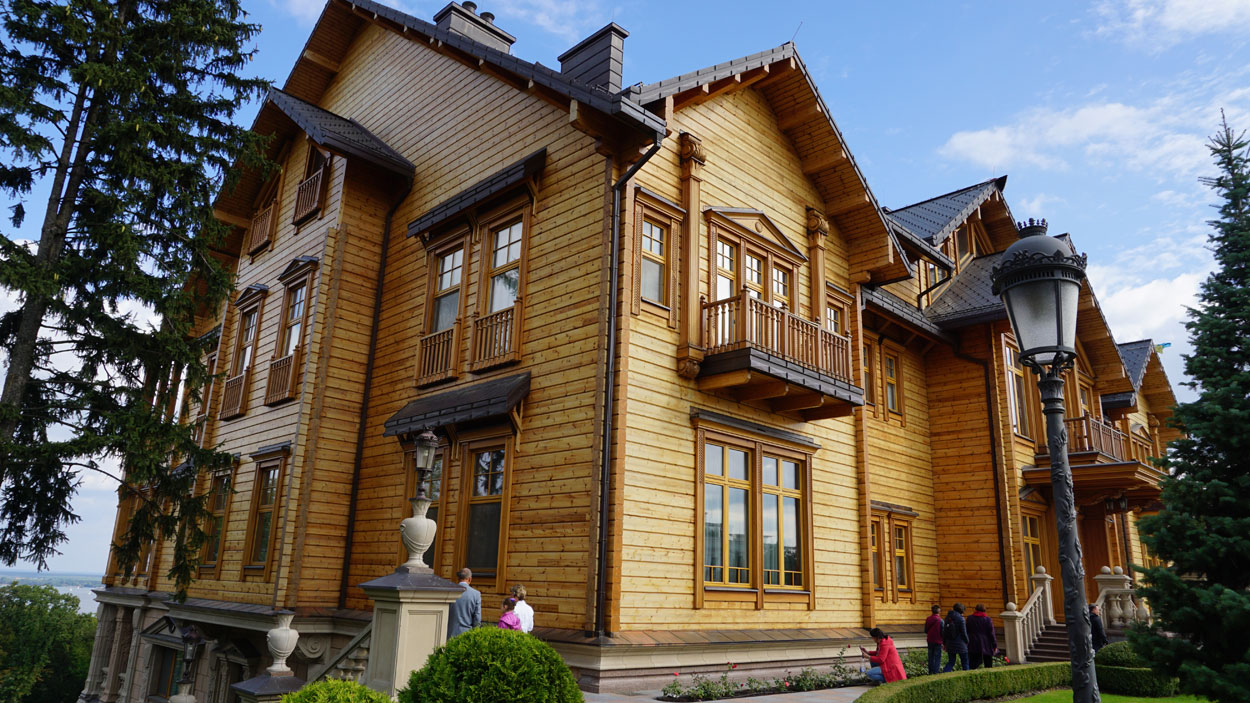
The mansion of deposed Ukrainian President Viktor Yanukovych in springtime. (Photo: Nolan Peterson/The Daily Signal)
“Ukraine still has a long way to go with its reforms, but the situation is not all doom and gloom, as is often reported,” Heritage’s Coffey wrote. “The country still faces many challenges on the political, economic, and security fronts. But it is about time we start measuring Kyiv’s success by its actual progress and not by unrealistic expectations.”
Like the bullet holes at the top of Heroes of the Heavenly Hundred Street, evidence of Ukraine’s evolution is sometimes easily overlooked.
At Mezhyhirya, where a Libyan dictator once visited, Ukrainian families now peacefully wander through Yanukovych’s palatial gardens and curiously poke through the deposed strongman’s garish dining halls and bedrooms. They shake their heads in disbelief at the absurdity and villainy of it all.
This monument to the perversion of power now stands as incontrovertible evidence as to the justice of the cause for which those more than 100 protesters died four years ago—and for which Ukraine’s soldiers and reformers still fight.
Even after all they’ve endured these past four years, for most Ukrainians, criminal rule is no longer seen as a tolerable trade-off for the sake of tranquility.
“Of course, there is disenchantment and sadness, but I think everything must not happen at once. We did our internal revolution, while the aggressor state attacked us. Who could have foreseen that?” 25-year-old Olesia Zhukovska, a volunteer paramedic during the 2014 revolution, said in an interview with the Ukraine Crisis Media Center last week.
A sniper shot Zhukovska through the neck on Feb. 20, 2014.
“I have no regrets,” Zhukovska said in the interview. “I regret neither coming to Maidan, nor my injury. It is an important lesson to me. When I took to Maidan, I wanted the changes in the country and in my life. It is exactly what happened.”
Life Goes On
On Thursday afternoon in central Kyiv, the commemoration ceremonies are all over.
Traffic is flowing again on Khreshchatyk.
Life goes on, as it always, amazingly does.
Yet, white paper angels remain tied to the bare branches of the trees lining Heroes of the Heavenly Hundred Street.
At the top of that cobblestone street, the black memorial to the fallen protesters remains covered in colorful flowers.
Near sunset on this workday, pedestrians stream by the memorial, heading to a nearby metro station for the commute home. But, like water piling up at a boulder in a river rapid, many people slow down to study the engraved faces of the dead.
Quite a few stop to just stand and stare.
One middle-aged woman in a long black coat and with a single rose in her hand stands apart.
Alone, she weeps.
As the daylight dims, she walks up to the memorial, places the flower beneath one of the faces of the dead, and says softly and simply in Ukrainian, “Thank you.”

